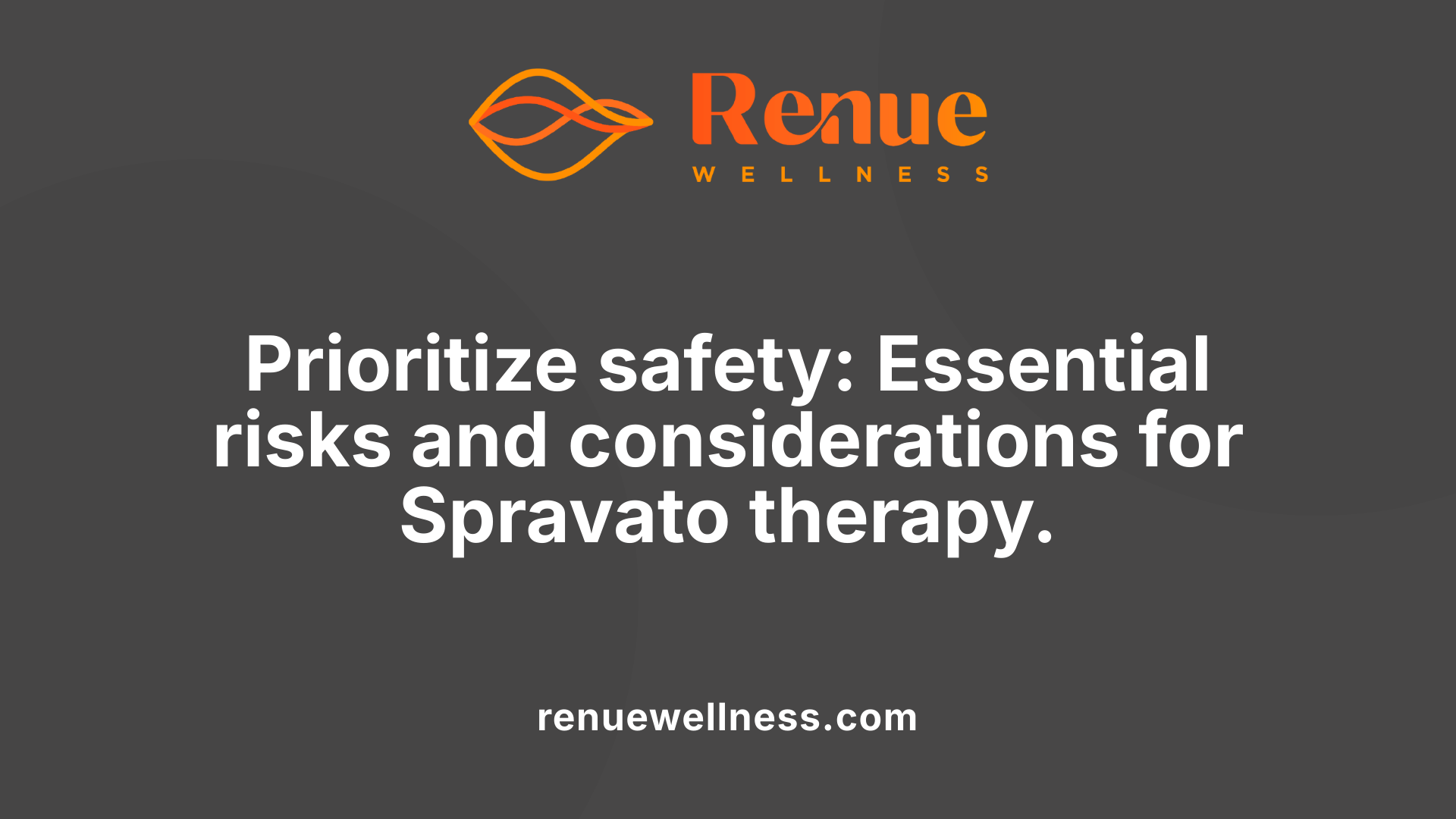Is Spravato Right for You? Key Eligibility Criteria and What to Expect


August 18, 2025
A Breakthrough in Depression Treatment
For individuals battling treatment-resistant depression (TRD) and severe depressive episodes, traditional antidepressants might not always bring relief. Recently, the FDA-approved nasal spray medication, Spravato (esketamine), has emerged as a promising option offering rapid symptom alleviation. This article explores key eligibility criteria, what the treatment involves, safety considerations, and how to determine if Spravato is suitable for your circumstances.
Understanding Who Is Eligible for Spravato Therapy

What are the eligibility criteria for Spravato treatment?
To qualify for Spravato (esketamine) therapy, patients must have a diagnosis of treatment-resistant depression (TRD). This means they have not experienced sufficient improvement after trying at least two different antidepressants from distinct classes, taken at appropriate doses and durations. Additionally, the medication is approved for adults with major depressive disorder (MDD) who are experiencing suicidal thoughts or actions.
Candidates must undergo a thorough evaluation by healthcare providers to confirm diagnosis and assess overall health. They should not have certain health risks that may exacerbate side effects, such as uncontrolled high blood pressure, aneurysms, or a history of intracerebral hemorrhage.
Since Spravato can cause sedation, dissociation, respiratory depression, and has potential for abuse, treatments are only administered in certified medical centers under strict supervision, following the FDA's REMS program. Women who are pregnant or breastfeeding should discuss alternative options, as safety in these populations is not yet established.
In summary, eligibility depends on both the failure of prior antidepressant treatments and the absence of specific medical contraindications, ensuring safe and effective use of this innovative therapy.
Is Spravato Suitable for Your Condition? How to Assess Personal Fit

How do I know if Spravato is suitable for my condition or circumstances?
Determining whether Spravato (esketamine) is the right treatment for you begins with a thorough evaluation by a healthcare professional. This medication is specifically designed for adults suffering from major depressive disorder (MDD), especially those who haven't responded to at least two previous antidepressant treatments, a condition known as treatment-resistant depression (TRD).
Your healthcare provider will assess the severity of your depression, considering factors such as the intensity of your symptoms and the presence of suicidal thoughts or actions. They will also review your medical history, including any underlying health conditions like high blood pressure, vascular issues, or previous medication responses. Because Spravato acts quickly—often providing relief within hours or days—it is typically recommended for severe cases where rapid symptom reduction is needed.
Additionally, your provider may evaluate if your treatment plan could benefit from combining Spravato with psychotherapy or other supportive therapies to maximize outcomes. They’ll also consider contraindications, such as uncontrolled hypertension or aneurysms, and ensure your safety during treatment. Overall, eligibility is personalized, based on comprehensive health assessment and individual circumstances, ensuring that this innovative treatment aligns with your specific needs and health status.
For more detailed information about suitability, consult your healthcare provider, or search for resources using terms like "spravato suitability mental health assessment eligibility".
The Treatment Process: What to Expect During Spravato Therapy

Initial assessment and consent
Your journey with Spravato begins with an in-depth consultation with your healthcare provider. They will review your medical history, confirm your diagnosis of treatment-resistant depression (TRD) or major depressive disorder (MDD) with suicidal thoughts, and evaluate whether you are a suitable candidate. This assessment includes checking blood pressure, heart health, and screening for any contraindications such as aneurysms or recent stroke. Once deemed eligible, you will be asked to give informed consent, understanding both the potential benefits and risks of the treatment.
Administration procedures in a certified treatment center
Spravato is administered as a nasal spray in a specialized, certified treatment facility. Under the supervision of trained medical staff, you will self-administer the nasal spray in each nostril, typically using one spray per side. The clinical staff ensures the correct dosage and monitors your vital signs throughout the process. The environment is designed to prioritize safety, with staff ready to handle any adverse reactions.
Monitoring during and after treatment
Following each dose, you will be observed by healthcare professionals for at least two hours. During this period, your blood pressure will be regularly checked, as increased blood pressure is a common side effect. You may experience dissociation, dizziness, nausea, or perceptual changes such as feeling disconnected or floating sensations. Staff will assess your physical and mental well-being before releasing you. It is essential to have a responsible adult to escort you home since you should not drive or operate machinery for at least 24 hours after treatment.
Frequency and duration of sessions
The initial phase of Spravato therapy involves administering the nasal spray twice weekly for four weeks. This schedule helps to establish an early response and manage side effects. Afterward, the frequency is gradually reduced to weekly or every other week, depending on your progress and doctor's assessment. Treatment duration varies among individuals but often continues for several months, with ongoing monitoring to determine the best maintenance plan. Regular sessions in a clinical setting are necessary to ensure safety and optimize therapeutic outcomes.
| Step | Description | Time Frame | Safety Measures |
|---|---|---|---|
| Initial assessment | Medical history review and eligibility check | Before first dose | Blood pressure, contraindications evaluation |
| Administration | Nasal spray self-dosed under supervision | Approximately 2-5 minutes | Monitoring of vital signs during dose |
| Observation | Post-treatment monitoring | At least 2 hours | Blood pressure, side effect watch |
| Follow-up | Scheduled treatments | Every week or biweekly | Safety checks and response assessment |
Safety First: Key Considerations and Risks of Spravato Therapy

What safety considerations should I be aware of with Spravato therapy?
Spravato (esketamine) therapy requires careful attention to safety due to its potential risks and side effects. It is associated with serious adverse reactions that mandate strict medical oversight. One of the most important safety features is its boxed warning, which highlights risks such as sedation, dissociation, respiratory depression, abuse potential, and an increased risk of suicidal thoughts in individuals under 24.
Because of these dangers, Spravato can only be administered at certified treatment centers involved in the REMS (Risk Evaluation and Mitigation Strategy) program. During each session, healthcare providers monitor patients closely for at least two hours post-administration. This monitoring includes checking blood pressure, mental state, and vital signs to ensure patient safety.
Prior to starting treatment, clinicians evaluate medical history thoroughly. Conditions like uncontrolled high blood pressure, vascular abnormalities, aneurysms, or recent brain hemorrhages are contraindications, meaning Spravato should not be used in these cases. Throughout treatment, patient's responses are carefully observed to quickly address any adverse effects.
Post-treatment, patients are advised not to drive or operate machinery for at least 24 hours, because the medication’s effects—including sedation and dissociation—can impair alertness. Serious side effects, such as hypersensitivity reactions or significant increases in blood pressure, require immediate medical intervention.
Overall, safety in Spravato therapy is maintained through strict adherence to protocols, thorough medical assessments, and continuous supervision to significantly reduce the risk of adverse outcomes.
Mechanism of Action and Purpose of Spravato: How It Works to Combat Depression

What is the mechanism of action of Spravato, and what is its purpose?
Spravato (esketamine) operates through a unique neurobiological pathway that sets it apart from traditional antidepressants. Its primary function is to target NMDA (N-methyl-D-aspartate) receptors in the brain—a specific type of glutamate receptor involved in brain signaling and mood regulation.
By blocking these NMDA receptors on inhibitory interneurons, esketamine transiently increases glutamate activity, the brain's main excitatory neurotransmitter. This surge in glutamate signaling enhances neural communication and promotes neuroplasticity—the brain's ability to adapt and reorganize synaptic connections.
This process also activates downstream pathways, such as the production of brain-derived neurotrophic factor (BDNF) and mammalian target of rapamycin (mTOR) signaling. These pathways contribute to forming new synapses and strengthening existing ones, which helps to rapidly improve mood symptoms.
Unlike traditional antidepressants that slowly increase serotonin or norepinephrine levels over weeks, Spravato's action quickens the timeline by fostering brain adaptability directly. This rapid mechanism allows patients, especially those with treatment-resistant depression, to experience symptom relief within hours or days.
The main purpose of Spravato is to serve as a fast-acting option for managing depression, particularly in urgent cases where immediate symptom control is essential. It is prescribed for adults who have not responded adequately to other treatments, providing a new therapeutic avenue leveraging neuroplasticity for mental health improvement.
Empowering Your Mental Health Journey
Understanding the eligibility criteria, treatment expectations, safety considerations, and mechanisms of Spravato is crucial for anyone considering this innovative therapy. While it offers promising rapid relief for treatment-resistant depression and severe symptoms, it demands careful medical evaluation and professional supervision to ensure safety and efficacy. Discussing your mental health history with your healthcare provider, evaluating your specific circumstances, and exploring insurance and support options can help you make informed decisions. If you think that Spravato might be the right step toward managing your depression more effectively, consult with a qualified mental health specialist to develop a personalized treatment plan suited to your needs.
References
- Is SPRAVATO ® Right for Me?
- Who is a Candidate for SPRAVATO®? Patient Eligibility and ...
- SPRAVATO® Affordability & Treatment Support
- Understanding Spravato: 10 Questions to Ask Your Health Provider
- TMS, Spravato, Therapy & Medication: What to Expect?
- What Is Spravato and How Does It Work? - Lone Peak Psychiatry
- What to Expect at Your First Spravato Appointment
- Am I a Candidate for Spravato? - Palo Alto Mind Body
Recent Posts
Conditions Treated
AnxietyDepressionOCDPTSDPostpartum DepressionPain ManagementSubstance AbuseSuicidal IdeationOur Location


